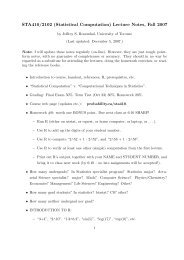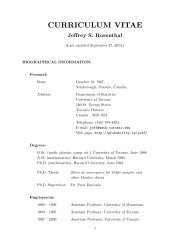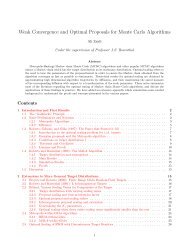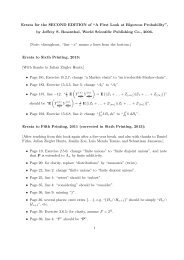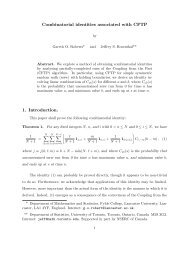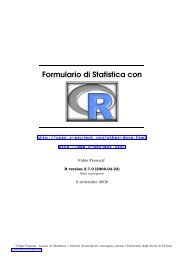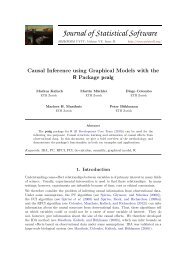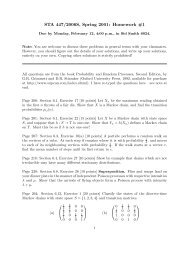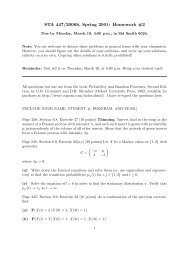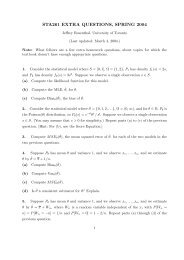Package 'extRemes' - What are R and CRAN?
Package 'extRemes' - What are R and CRAN?
Package 'extRemes' - What are R and CRAN?
You also want an ePaper? Increase the reach of your titles
YUMPU automatically turns print PDFs into web optimized ePapers that Google loves.
34 fevd<br />
## S3 method for class fevd<br />
summary(object, ...)<br />
## S3 method for class fevd.bayesian<br />
summary(object, FUN = "mean", burn.in = 499, ...)<br />
## S3 method for class fevd.lmoments<br />
summary(object, ...)<br />
## S3 method for class fevd.mle<br />
summary(object, ...)<br />
Arguments<br />
x<br />
object<br />
data<br />
threshold<br />
fevd: x can be a numeric vector, the name of a column of data or a formula<br />
giving the data to which the EVD is to be fit. In the case of the latter two, the<br />
data argument must be specified, <strong>and</strong> must have appropriately named columns.<br />
plot <strong>and</strong> print method functions: any list object returned by fevd.<br />
A list object of class “fevd” as returned by fevd.<br />
A data frame object with named columns giving the data to be fit, as well as any<br />
data necessary for modeling non-stationarity through the threshold <strong>and</strong>/or any<br />
of the parameters.<br />
numeric (single or vector). If fitting a peak over threshold (POT) model (i.e.,<br />
type = “PP”, “GP”, “Exponential”) this is the threshold over which (non-inclusive)<br />
data (or excesses) <strong>are</strong> used to estimate the parameters of the distribution function.<br />
If the length is greater than 1, then the length must be equal to either the<br />
length of x (or number of rows of data) or to the number of unique arguments<br />
in threshold.fun.<br />
threshold.fun formula describing a model for the thresholds using columns from data. Any<br />
valid formula will work. data must be supplied if this argument is anything<br />
other than ~ 1. Not for use with method “Lmoments”.<br />
location.fun, scale.fun, shape.fun<br />
formula describing a model for each parameter using columns from data. data<br />
must be supplied if any of these arguments <strong>are</strong> anything other than ~ 1.<br />
use.phi<br />
type<br />
logical; should the log of the scale parameter be used in the numerical optimization<br />
(for method “MLE”, “GMLE” <strong>and</strong> “Bayesian” only)? For the ML <strong>and</strong><br />
GML estimation, this may make things more stable for some data.<br />
fevd: character stating which EVD to fit. Default is to fit the generalized extreme<br />
value (GEV) distribution function (df).<br />
plot method function: character describing which plot(s) is (<strong>are</strong>) desired. Default<br />
is “primary”, which makes a 2 by 2 panel of plots including the QQ plot<br />
of the data quantiles against the fitted model quantiles (type “qq”), a QQ plot<br />
(“qq2”) of quantiles from model-simulated data against the data, a density plot<br />
of the data along with the model fitted density (type “density”) <strong>and</strong> a return level<br />
plot (type “rl”). In the case of a stationary (fixed) model, the return level plot<br />
will show return levels calculated for return periods given by return.period,



